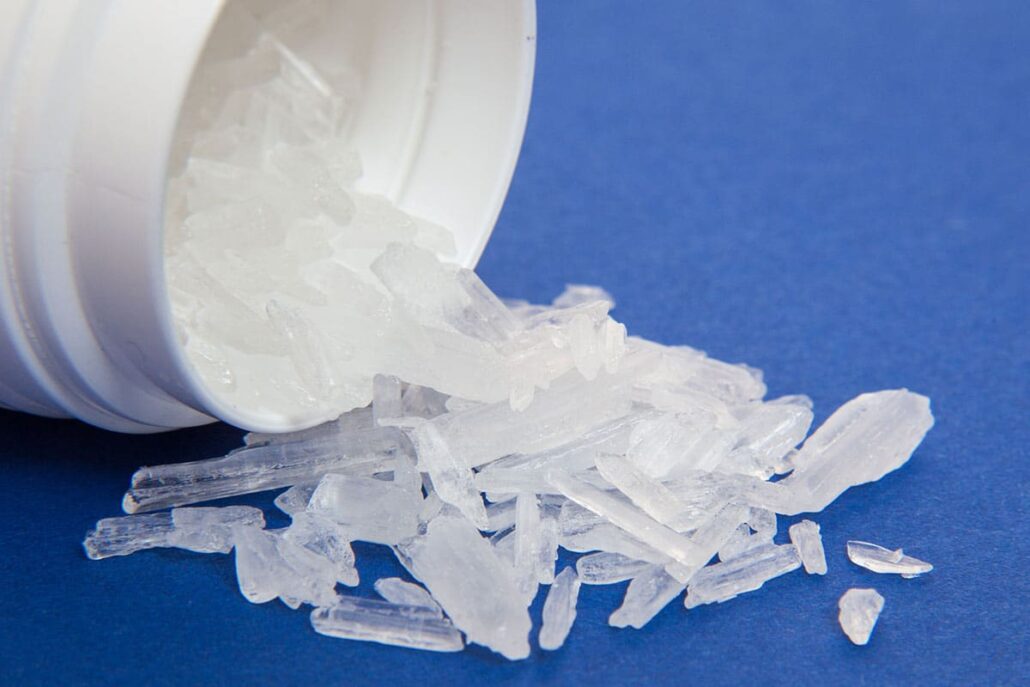Methamphetamine, widely known as crystal meth, is potent and highly addictive stimulant that casts a dark shadow on the lives of individuals and communities worldwide.
The worst part is that meth addiction extends beyond physical effects, seeping into the fabric of mental health and social harmony.
According to the National Survey on Drug Use and Health (NSDUH), in 2019, around 19 million people in the U.S. over 18 had tried methamphetamine at least once in their lifetime.

An analysis by the Centers for Disease Control and Prevention showed that deaths from methamphetamine overdoses had doubled from 2.1 to 5.6 per 100,000 between 2015 and 2019.
Despite its highly addictive nature, recovery from methamphetamine addiction is possible, thanks to meth detox.
Table of Contents
Understanding Meth Addiction
methamphetamine, commonly known as meth, is a potent and extremely addictive CNS stimulant. Crystal meth is the most popular form of this drug, which looks like shiny white rocks or glass fragments. Chemically, methamphetamine is similar to amphetamine, a CNS stimulant used to treat narcolepsy and ADHD.
The synthetic nature and powerful effects of methamphetamine on the brain make it one of the most insidious drugs in the world. It exerts profound physical and psychological effects on those who fall under its influence. But how, exactly?
Methamphetamine’s addictive nature comes from its ability to flood the brain with dopamine, a neurotransmitter responsible for feelings of pleasure and reward. This makes it incredibly challenging for meth abusers to quit the drug, even when faced with detrimental consequences.
People abuse meth using various ways, such as smoking, inhalation, powder injection, and snorting. We often hear people refer to methamphetamine as “speed” or “crank.” These names don’t come from nowhere.
They come from the fact that the effects of methamphetamine start and fade quickly, leading individuals to binge-take the drug in a form named “run.” Abusers can totally give up on food, drinks, and sleep just to continue taking the drug for several days.
Since meth can substantially increase the amount of dopamine in the brain, people abuse it to experience a sense of euphoria and energy. But as they continue using meth, they become trapped in a pattern of repeated use, chasing the short-term high. But how does meth actually affect the human body?

Signs and Symptoms of Meth Addiction
Identifying the signs and symptoms of meth addiction is a crucial step in the sobriety journey.
While not all meth abusers exhibit the same behavioral and physical changes, there are some common signs and symptoms that are often linked to meth abuse:
Physical Symptoms
- Insomnia.
- Hypersomnia.
- Elevated body temperature.
- Excessive perspiration.
- Unexplained weight loss.
- Foul body odor.
- Uncontrolled twitches and muscle spasms
- Increased heart rate and blood pressure.
- Loss of appetite
- Appearance changes in physical appearance, including acne, skin sores, and tooth decay.
Behavioral Symptoms
- Lying
- Stealing
- Impulsive and unpredictable actions
- Sudden bursts of hyperactivity
- Paranoia
- Social isolation
- Frequent absences from school or work
- Prolonged periods of lethargy
- Rapid speech
Cognitive and Emotional Symptoms
- Chronic anxiety
- Hallucinations
- Confusion
- Difficulty learning
- Loss of memory
- Delusions
- Anxiety and depression
- Increased alertness
Risk Factors for Developing Meth Addiction
Meth abuse doesn’t emerge in a vacuum. It’s influenced by a complex web of individual, environmental, social, and genetic factors.
Understanding these risk factors isn’t only important in treating meth addiction but also in identifying individuals who might be more susceptible to abusing meth and other drugs.
- Genetic Predisposition: As with any other drug, people with a family history of substance abuse are more likely to develop addiction.
- Early Exposure: Initiation of drug use at an early age, especially during adolescence, is a risk factor for developing addiction. The developing brain is much more vulnerable to the long-term effects of meth.
- Environmental Factors: Growing up in communities where meth is available can easily increase the risk of abuse. Peer pressure and social circles can also encourage meth use, especially young adults.
- Co-occurring Mood Disorders: People suffering from mental health disorders such as depression, anxiety, and schizophrenia may shift to methamphetamine and other drugs as self-medication, increasing the risk of addiction.
- Trauma: Traumatic experiences in childhood, such as sexual or physical abuse, increase the risk of developing substance abuse.
- Frequent Use of Drugs: abusing drugs for extended periods increases the risk of developing addiction. In the case of meth, even short-term drug abuse can lead to long-term dependence.
- Neurobiological Factors: Studies have shown that individuals prone to addiction may have different brain and CNS functioning, and the structure of their brains can also be different from non-addicts.
The Need for Meth Detox
As we mentioned, methamphetamine is an extremely addictive substance that has a significant impact on one’s mental and physical well-being. That’s why following a detailed and structured detoxification process is imperative as an initial step to recovery from meth addiction.

Meth addiction takes a toll on one’s physical health, leading to issues such as dental decay, cardiovascular problems, and malnutrition. Meth detox helps address and stabilize these issues under the supervision of medical professionals.
More importantly, meth detox isn’t just about getting rid of meth from the body. It’s a systemic approach that helps individuals deal with the intense withdrawal symptoms of meth.
Cessation of methamphetamine triggers a wide range of undesirable symptoms such as depression, increased appetite, suicidal thoughts, intense cravings, anger, fatigue, and more.
On top of that, meth detox programs help individuals deal with the overwhelming psychological impact of meth withdrawal which includes symptoms such as hallucinations and anxiety.
The program provides therapeutic interventions and psychological support to individuals to cope with these challenges smoothly.
Quitting Meth Cold Turkey
No doubt, many individuals struggling with meth addiction recognize the profound damage the drug has on their lives. That’s why they may try to quit the drug on their own, or what’s known as “cold turkey.” However, this is never the right approach, and that’s for several reasons.
The potent cravings, compulsive behavior, and lack of adequate social support create a barrier that leads many meth abusers back to the meth use cycle.
That’s why meth abusers find it extremely challenging to control their cravings on their own. But guess what? It’s not just about discipline and self-control.
When people try to quit meth cold turkey, they experience intense withdrawal symptoms. These symptoms are often experienced during the first 24 hours of meth cessation, and they include the following:
- Intense cravings
- Depression
- Psychosis
- Disturbed sleep
- Rapid mood swings
- Anxiety
- Irritability
- Extreme fatigue
- Unpleasant dreams
- Fatigue
These acute withdrawal symptoms can last up to 7 or 10 days, but the neurotoxic effects can persist for months.
The relentless floods of dopamine induced by methamphetamine eventually reduce the number of dopamine receptors. It can take up to several days, months, or years for the brain to heal and start functioning normally.

The Meth Detox Program
The meth detox program is a multi-stage approach designed to manage the withdrawal symptoms and long-term effects of meth addiction.
The detox process typically begins with a thorough initial assessment by medical professionals. This evaluates the individual’s overall health, history of meth abuse, mental health status, and co-occurring health conditions.
The specific timeline of meth withdrawal varies from one individual to another. However, there are many common withdrawal symptoms among all meth abusers. Here’s an example of a meth recovery timeline:
First 48 Hours
Known as the crash phase, the first two days after meth withdrawal involve a sharp decline in energy and cognitive function.
Other common symptoms during this phase include the following:
- Nausea: GIT disturbances such as nausea and vomiting are prominent in the first two days after meth withdrawal. Treating these symptoms includes adequate hydration and rest.
- Abdominal Cramps: Colicky pain in the abdominal region is usually experienced during this period. Patients need to consume smaller meals to reduce the pain intensity. They might also be prescribed medications to alleviate the pain.
- Sweating: intense sweating is common during the first two days after meth withdrawal. It’s usually accompanied by increased heart rate and dilatation of blood vessels.
3-10 Days
At this stage, withdrawal symptoms are usually at peak. That’s when the body starts to adjust to function normally without meth.
Here are the most common symptoms during this phase:
- Anxiety: Individuals often experience everyday nervousness and anxiety. These symptoms may be accompanied by restlessness, tension, a constant sense of danger, and trembling.
- Extreme Fatigue: fatigue is prevalent in this phase. It stems from depression and anxiety. Combating fatigue is possible through regular exercise and a balanced, healthy diet.
- Depression: since meth addicts are used to the intense dopamine levels. They experience severe depression after meth withdrawal.
14-20 Days
Most physical symptoms begin to subside by the end of the second week. However, the intense drug cravings persist.
Individuals often experience these symptoms during this phase:
- Intense Cravings: Meth withdrawal brings intense cravings during the first two weeks. While they come in waves, exercising, staying busy, and sticking to a healthy diet helps.
- Depression: Depression from the last period may extend. It’s often marked by feelings of hopelessness and feelings of low self-worth.
- Continuing Fatigue: fatigue persists for up to 20 days after meth withdrawal. Healthy eating and exercise help in reducing fatigue and restoring energy.
Over 1 Month
At this point, most withdrawal symptoms are over. The remaining symptoms will subside over time, but some people still experience long-term depression and anxiety for several months.

What to Expect in Meth Detox
Most meth abusers are reluctant to take the first step in their sobriety journey because they fear the intense withdrawal symptoms. But fortunately, meth detox programs are carefully designed to help individuals cope with the withdrawal symptoms.
Not all detox programs work the exact same way, but the majority of programs consist of three main phases:
Initial Evaluation
After admission, a professional team of doctors and nurses evaluate each individual using different drug screening methods to determine the amount of drug in each patient’s body. This helps doctors determine the fastest and easiest way to remove the drug from patients’ bodies.
The initial assessment also allows doctors to create personalized healthcare plans for each patient based on their needs and overall health. Doctors often ask questions about medical history, drug use patterns, and co-occurring health conditions.
Stabilization
Following the initial assessment, treatment starts promptly to facilitate the individual’s comfort and address the present withdrawal symptoms. This is a crucial step since most meth abusers suffer from severe withdrawal symptoms at the time of their admission.
Once the doctors observe progress, they modify interventions to promote stabilization.
Transition into Further Treatment
As we mentioned earlier, detox is only the first step of the recovery plan. Once the detox process ends, physicians decide the next step for each patient to complete their addiction treatment. Physicians suggest that the next steps of the treatment plan are carried out inside a rehab facility.
Medications Used in Meth Detox
Unfornutantly, there’s no FDA-approved medication to treat meth detox. However, patients are often prescribed multiple medications throughout the detox process to ensure they handle the withdrawal symptoms.
For example, antidepressants such as paroxetine and fluoxetine can help manage symptoms of depression and anxiety that accompany meth withdrawal. Bupropion is another anti-depressant used in smoking cessation programs, but it can also reduce cravings associated with meth withdrawal.
Since meth withdrawal is accompanied by insomnia, individuals are usually prescribed non-addictive sleep aids to help them with sleep disturbances.

To Wrap Up
There you have it, everything you need to know about the ins and outs of meth detox. Getting clean from meth can be challenging, but it’s definitely possible with the right approach, dedication, and self-discipline.
Meth detox is a pivotal step forward towards a sober life. Given the intricate challenges of meth withdrawal, such as intense cravings, lingering fatigue, and depression, following a structured and supervised detoxification process is a must.
Medical professionals play a huge role in managing withdrawal symptoms, ensuring safety, and tailoring the right treatment approach. Beyond detox, the recovery journey continues, and it involves group therapy, counseling sessions, and structured activities.
If you or any of your loved ones are having meth abuse problems, don’t hesitate to seek professional help.
Please contact Long Island Interventions for information about Meth Addiction Treatment near you.
Drug & alcohol detox programs are not directly offered by Long Island Interventions. However, we do recognize that this type of addiction treatment is often necessary and vital to one’s long-term recovery from substance abuse. If you or a loved one require any services that we do not offer we would be glad to refer you to one of our trusted affiliate providers.

